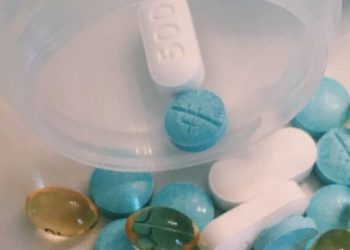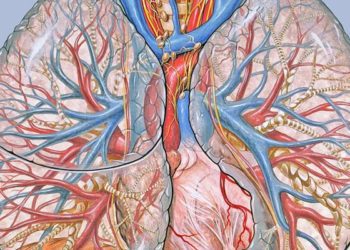2 Minute Medicine Rewind November 20, 2017
Tolvaptan in Later-Stage Autosomal Dominant Polycystic Kidney Disease
Tolvapatan, a vasopressin V2-receptor antagonist, has been shown to slow kidney growth and glomerular filtration rate (GFR) decline in early autosomal dominant polycystic kidney disease (ADPKD). However, the efficacy and safety of this drug is unknown in ADPKD patients with later stage disease. This double-blind, randomized, controlled trial enrolled 1,370 adults, either age 18 to 55 years with an eGFR of 25-65 mL per minute per 1.73 m2 of body-surface area or age 56 to 65 years with an eGFR of 25 to 44 mL per minute per 1.73 m2 of body-surface area. Patients were randomized to receive tolvaptan or placebo for one year and were followed up to assess for change in eGFR. Researchers found that the decrease in eGFR was significantly less in the tolvaptan group, yielding an average decline that was 1.27 mL per minute per 1.73 m2 of body-surface area less than the average decline in the placebo group (95% CI 0.86 to 1.68, p<0.001). Additionally, no elevations in bilirubin greater than twice the upper limit of normal were noted. However, 5.6% of tolvaptan-treated patients had a rise in aminotransferases 3 times above the upper limit of normal, as compared to 1.2% of patients treated with placebo. These elevations can be reversed with discontinuation of tolvaptan. Investigators therefore concluded that tolvaptan does, in fact, help in slowing the decline in estimated GFR in patients with later-stage ADPKD.
Abdominal aortic aneurysm rupture is an emergency associated with high mortality, necessitating treatment with either an open or endovascular repair. This randomized controlled trial assigned 613 patients to receive either an emergency open repair or to be managed with the endovascular strategy. The endovascular strategy dictates that patients undergo emergent computed tomography (CT) to assess whether or not the aorta is morphologically suited to endovascular repair, followed by endovascular or open repair, depending on the results of CT. Patients were followed for mortality, as well as secondary outcomes of quality of life, hospital costs, and reinterventions, all assessed at 3 years. Of the 502 patients who underwent repair, 3-year mortality was 42% in the endovascular strategy group, which was significantly lower than the 54% mortality rate amongst participants that underwent open repair (OR 0.62, 95% CI 0.43 to 0.88). The 7-year mortality rate, however, did not differ significantly between the two groups (OR 0.86, 95% CI 0.68 to 1.08). Reintervention rates between the two groups at 3 years also did not significantly differ. Quality of life, as measured by QALYs, was significantly higher in the endovascular group (difference 0.166, 95% CI 0.002 to 0.331). The esndovascular strategy also resulted in fewer hospital days and lower hospital costs. Investigators concluded that, at 3 years of follow-up, the endovascular strategy is associated with increased survival, better quality of life, as well as reduced costs.
Pharmacologic therapy to prevent relapse of opioid use is an important part of the response to the current opioid epidemic. Two therapies, extended release naltrexone (XR-NTX) and sublingual buprenorphine-naloxone (BUP-NX), are two drugs currently being used for this purpose. In this randomized controlled trial, adults age 18 years or older diagnosed with opioid use disorder were randomized to receive either monthly injections of XR-NTX or daily sublingual BUP-NX to compare the rate of opioid relapse-free survival with these two interventions. Patients were followed for relapse events over 26 weeks with relapse being defined as 7 consecutive days of self-reported opioid use or 4 consecutive weeks of non-study opioid use on urine drug screen or self-report. Using an intention-to-treat analysis with 570 study participants, researchers found that relapse was significantly greater in the XR-NTX group (HR1.36, 95% CI 1.10 to 1.68). However, 89% of these events were early relapse events secondary to induction failure with XR-NTX. When analyzing the 474 participants who were successfully induced, the incidence of relapse events was not significantly different between the two groups (p=0.44). Adverse events necessitating treatment also did not significantly differ between the two groups. Investigators concluded that both medications were safe and equally effective. However, XR-NTX induction is difficult and that adversely affects overall relapse rates.
Aspirin in Patients with Previous Percutaneous Coronary Intervention Undergoing Noncardiac Surgery
Patients that have previously received a percutaneous intervention (PCI) are at higher risk for complications when undergoing non-cardiac surgery. The benefits and harms of perioperative aspirin in this subpopulation are currently unknown. This subgroup analysis of a factorial trial aimed to investigate the effects of perioperative aspirin on the primary outcome of death or non-fatal myocardial infarction (MI), as well as the secondary outcome of bleeding. Adults age 45 years or older with prior PCI who had or were at risk for atherosclerotic disease (n=470) were randomized to receive either aspirin or placebo, initiated 4 hours prior to surgery and continued perioperatively. Researchers found that aspirin significantly reduced the incidence of death or nonfatal MI (HR 0.44, 95% CI 0.22 to 0.87, p=0.021). However, aspirin did significantly increase the risk for major bleeding (HR 1.22, 95% CI 1.01 to 1.48). Investigators therefore concluded that aspirin use might benefit patients with prior PCI when undergoing non-cardiac surgery. However, the risks of myocardial infarction have to be weighed against the risk of bleeding in the context of the specific type of non-cardiac surgery the patient is undergoing.
Durvalumab after Chemoradiotherapy in Stage III Non-Small-Cell Lung Cancer
Non-small cell lung cancer (NSCLC) has high rates of disease progression despite treatment with concurrent chemotherapy and radiotherapy. In this phase 3 randomized controlled trial, durvalumab, a monoclonal antibody against programmed death ligand 1, was investigated for its effects on progression-free survival and overall survival in NSCLC patients. Patients (n=709) were randomized 2:1 to receive either durvalumab or placebo, with both treatments administered every 2 weeks for up to 12 months. Researchers found that progression-free survival was significantly greater in the group treated with durvalumab as compared to the placebo group (HR 0.52, 95% CI 0.42 to 0.65, p<0.001). Progression-free survival rates at 12 and 18 months were also significantly increased in the durvalumab treatment group. Grade 3 or 4 adverse events occurred at similar rates between the two treatment groups. Investigators therefore concluded that progression-free survival is significantly greater in those treated with durvalumab, as compared to placebo, with acceptable safety profile.
Image: PD
©2017 2 Minute Medicine, Inc. All rights reserved. No works may be reproduced without expressed written consent from 2 Minute Medicine, Inc. Inquire about licensing here. No article should be construed as medical advice and is not intended as such by the authors or by 2 Minute Medicine, Inc.









